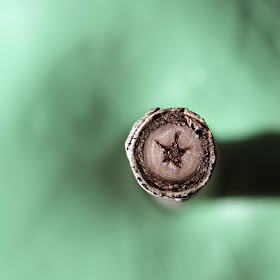Many years ago, in the heat of summer, little girls sat in the shade of cottonwood trees and made tipis from the leaves.
These they made in numbers and placed them in circles like the camp circle of their tribe.
 |
“A circle of cottonwood-leaf toy tipis made by Indian children of Plains tribes” (Gilmore 1919).
|
 |
| Lanceleaf cottonwood, Populus x acuminata. |
 |
A Plains cottonwood. I ate lunch in its shade every day during a grassland project.
|
It was the Plains cottonwood – Wága chan of the Dakota – that supplied leaves for toy tipis. In early October, I collected leaves from the Plains cottonwood in my yard, and spines from the matrimony vine (Lycium barbarum) to make my own, following the story carefully.
 |
| Building materials. |
They split a leaf a short distance down from the tip along the midrib; at equal distances from the tip they tore across from the margin slightly; then, bending back the margin above the rents for the smoke flaps, and drawing together the leaf-margins below the rents and fastening them with a splinter or a thorn, they had a toy tipi.
 |
Smoke flaps regulate draft and ventilate the tipi, especially smoke from the fire.
|
These [I] made in numbers and placed them in circles like the camp circle of [a] tribe.The toy tipi story comes from ethnobotanist Melvin Gilmore (1919). In the early 1900s he visited elderly Indians of the Great Plains who had gathered native plants and still knew the old names and uses. He hoped to document this knowledge "while it may still be obtained, before the death of all the old people who alone possess it.” They were happy to share the knowledge “in order that, as they said, future generations of their own people as well as the white people may know and understand their manner of life."
--- ✿ ✿ ✿ ✿ ✿ ✿ ✿ ---
Lanceleaf cottonwoods may not be good for leaf tipis, but like all cottonwoods, they do have stars inside. The story of the cottonwood star comes from rural Nebraska, by way of Kathleen Cain (2007). Her father once asked her “Have you ever seen the cottonwood star?” She hadn’t.
He turned the twig so I could gaze directly into its center. Running crosswise through the middle of the small piece of wood, the cut revealed a reddish-brown and nearly perfect five-pointed star.
You have to find one with a sturdy knuckle ... You have to cut cleanly ... No hacking. Not jagged. One cut is best.
 |
A Pex tube cutter worked well.
|
 |
A sturdy knuckle.
|
 |
A macro lens revealed the cottonwood star nicely. It’s only 6 mm across.
|
The path of the hidden star stretches out into the future of every cottonwood branch.
Sources
Cain, K. 2007. The cottonwood tree; an American champion. Boulder, CO: Johnson Books.
Gilmore, M.R. 1919. Use of plants by the Indians of the Missouri River region. Bureau of American Ethnology.



Those toy tipis are really cool. Thanks for sharing this with us :)
ReplyDeleteThanks, Tim. It was a lot of fun :)
DeleteNice! Did you ever make dolls from hollyhock blossoms, by any chance? I saw that done once when I was a child, and it seemed magical, but I have never seen of it since, and have no idea how it was done.
ReplyDeleteNo! It sounds wonderful. We have lots of hollyhocks in Laramie so I should look into it next summer.
DeleteBrilliant... your cottonwood trees are amazing Hollis. Gillian
ReplyDeleteThanks, Gillian :-) This tree-following has been so interesting and fun ... hooray for Lucy!
DeleteOh, I had no idea! I learned so much from this post--the five-pointed stars, the tipis. Wonderful! Did you know that Cottonwoods are larval hosts to Mourning Cloak butterflies? I recently discovered that after finding many Mourning Cloaks in the neighborhood. Our neighbors have a giant P. deltoides that hangs over a large portion of their yard and partially shades ours. It's an incredible tree, and supports many birds, butterflies, and wildlife. The only thing I don't like is the Cottonwood seed fluff in the late spring/early summer that covers everything. But it's worth it for all the value it brings to the critters and lovely creatures. :)
ReplyDeleteThanks, PP ... glad you enjoyed it. I did not know about the mourning cloak larvae. I have several Plains cottonwood trees in my yard, so something to look into next year. I'm thinking about choosing a Plains cottonwood next year as they were (still are in places) such important trees in the American West. I like the ties to history.
DeleteFascinating. The tipis are interesting and fun but I'm specially impressed by the star -- reminiscent of the joint between the leaf and twig which gives the Horse(shoe) Chestnut tree its name.
ReplyDeletecool, I had no idea ... about the horseshoes of the horse chestnut.
DeleteStars and tipis! I love it, what a rich vein of stories assoicated with cottonwoods.
ReplyDeleteThanks, Janet. I love the stories and the historical ties. I may choose a Plains cottonwood to follow next year, as it has so many.
DeleteHere's a Dakotah story from Mary Louise Defender about "The Star in the Cottonwood" https://www.youtube.com/watch?v=WPVvIKEi_d8
ReplyDelete